#Calusa culture
Text
Swamp Witch Travels: The Everglades
The Seminole War that never ended, a charm to Split a Storm and an Ancient Island. For centuries, the Everglades has been the object of wonder of many influential Floridian figures who each recognized its immense beauty and power. This River of Grass is a major center of life and biodiversity, as well as mysteries and Spirits uncharted, but will it still be around for the Swamp Witches of tomorrow?
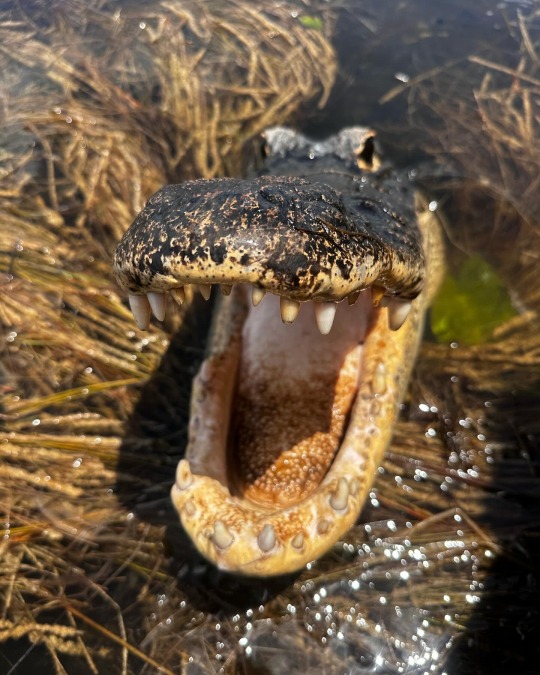
The Everglades is going to shatter all of your preconceived notions about Swamps. It is a place of great power and duality. On one hand, this aqueous Land is covered in sparkling, clear, MOVING water. This water is the Life and Blood of the state, flowing from the Heart of the Everglades, Okechobee (Big Lake) The health of this ecosystem in turn affects the entire country. On the other hand, a place of Danger, Death and Rot, but for the purpose of Cleansing and Purification (not just rot for rot’s sake). As the water flows through this vast ecosystem, it is cleared of pollutants by plants and limestone while washing away scars left by man on this Land, until all is returned anew. It is a multifaceted, firm but gentle Spirit.
The Everglades is a union, a pact almost, between the Land and the Water to form the Swamp we know and love.
I am no stranger to the Glades. I was born and raised in the western Everglades, in the Big Cypress water basin. Fakahatchee and Picayune Strand were favorites of my parents as I was growing up, and we lived way out in the woods anyways so I always feel at home in the Glades. Many of my Spirits who are intrinsically tied to me, one might call a Spirit Guide or Angel, feel connected to Swamps and places where Water and Land converge. The Everglades is my home, but it is also a Spirit Ally, and a sacred place to the modern Indigenous Peoples of Florida, including the recognized and unrecognized Seminole and Miccosukee.
(PSA: this post will likely be part of a series only scratch the surface of the intricacies related to the Glades.)
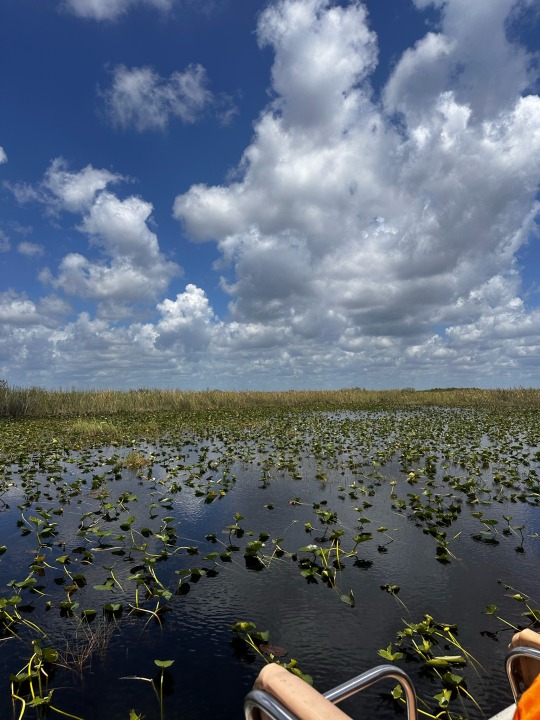
Pa-Hay-Okee, “Grassy Waters”
Pa-Hay-Okee is the Seminole-Mikasuki name for the Everglades. I was blessed to be able to take a trip to see the Real Florida when I took an airboat ride with Buffalo Tiger Airboats, owned and operated by Betty Osceola. Betty is a conservationist and member of the Miccosukee tribe, located in the Eastern Everglades. The Seminole and Miccosukee are the descendants of various groups of Florida’s Original People from all over the state. The relationships and history of Florida’s Indigenous groups is complex. Before colonization and to this day we have had multiple groups who all have different beliefs, cultures, origins, and relationships. Today, we have various groups who are federally recognized as well as both Traditional and Reconstructionist groups who don’t seek recognition from the government, the most well-known being the Traditional Seminoles in Big Cypress.
Certain aspects of Seminole culture predate colonization, like the Chickee and some hunting techniques, while others, mainly linguistic and spiritual, are the result of groups joining together or adapting to new circumstances, such as patchwork. Many of the Seminole can trace their ancestry to groups in North Florida and surrounding states. These groups would live in various parts of the State, including the Everglades, at different times of the year following routes taken by seasonal migrations of game and water.

These people were forcibly removed, pushed South or murdered so their land could be taken in a conflict known to the United States as the First, Second and Third Seminole Wars. As they were pushed South, they encountered and assimilated various remaining populations of Pre-Columbian groups like the Calusa and Tequesta.
If you ask the modern members of these tribes, they will tell you it was a single war that is still being fought to this day, although with lawyers instead of weapons. You see, the Seminole and Miccosukee still have never signed a treaty with the US, and continue to have to fight for their Sovereignty and Land to this day. This has earned the Indigenous People of Florida the title of the Unconquered Peoples. Today, the tribes maintain traditional ways while also dealing with ever-encroaching settler beliefs and people. They still live off the land, but through the lens of eco-tourism most often rather than through subsistence living like many elders lived in their youth.
On my airboat trip, I got to stop and walk around Tear Island, a place where two Indigenous families began living in the 1800s and then abandoned in the 1920s. Being on these far off Islands, surrounded by the swamp and only accessible by boat, is where I feel most connected to my own Indigenous Taino ancestors, who would have traversed this same place but in a dugout canoe rather than an Airboat. The spirits of generations of people who lived and passed on are still here, within the water and trees, but also gathering around the cooking chickee when a fire is lit by their descendants.
High Tide at Chokoloskee
Known as the Western Gateway to the Everglades, we have Everglades City. It borders the Big Cypress Preserve and is a great place to stop to visit the Museum of the Everglades. The first settlers came here in the 1800s, it was incorporated in 1923. Past Everglades though, lies Chokoloskee. An Island with a Seminole name meaning ‘Old House’. This Island was only reachable by boat until 1956 when the bridge was built. John Weeks, the first permanent settler of Naples was one of the first settlers here as well. Before that, it was inhabited by the Calusa for more than 1,500 years.

Stop by HavAnnA Cafe on your way to the southern tip of the Island where you’ll find a large red building on stilts. This is the Smallwood Store. Founded in 1906 by Ted Smallwood, this store was one of the only places Indigenous and White Floridians could go to trade for necessities. Ted Smallwood was a well-known ally of the Seminole and Miccosukee peoples, even learning to speak the language. Today, his granddaughter runs the store which is a museum and gift shop. There is even a replica of Ted himself, pictured above.
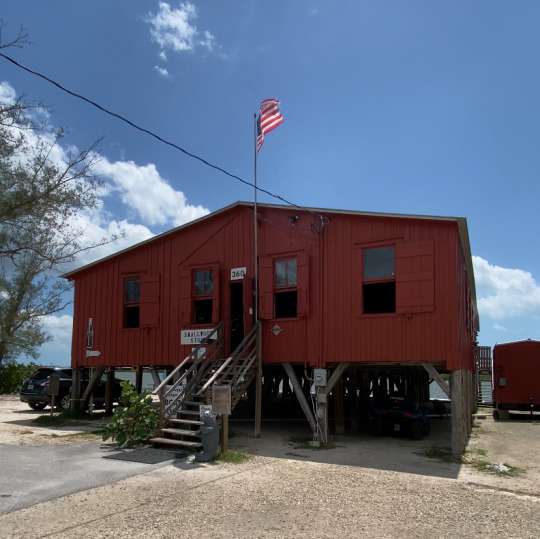
This history of this store and island is long, and tragic. A nearby massacre during the ‘Third Seminole War’ caused the remaining Indigenous people here to flee the Island. Later on, a famous murder of a well known criminal happened right outside the Smallwood Store. You can read more about both, and the 100 year anniversary of the building being raised here.
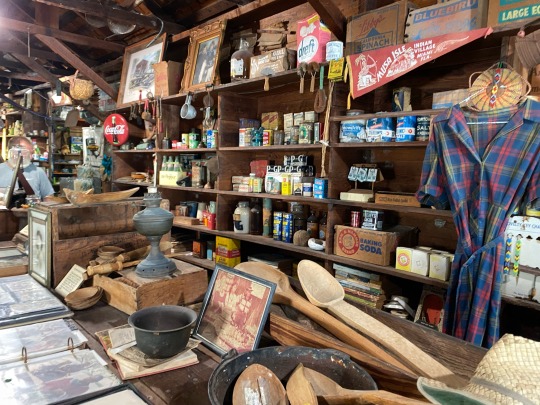
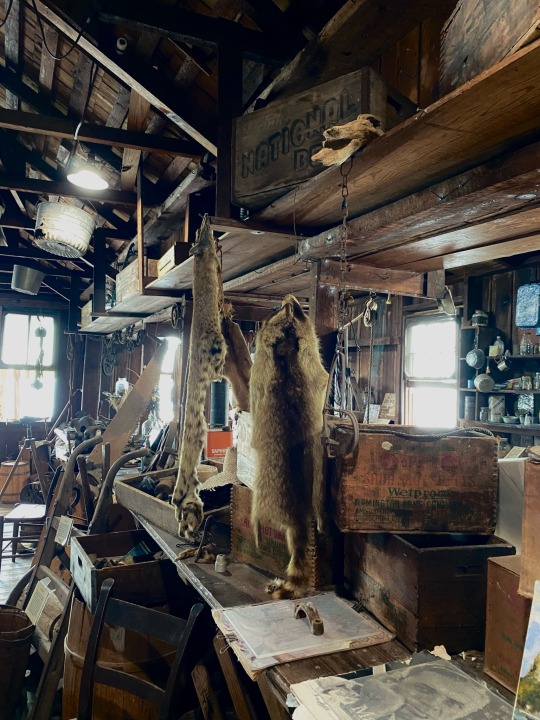
This is also a great spot to see where the fresh water of the Everglades meets the saltwater of the Florida Bay. Definitely give this place a visit.

Splitting Storms: An Indigenous Folk Protection Charm
For some time now, I have noted the striking similarities between Seminole and Taíno beliefs around Twins and Weather. We even share a simple protection charm to ward off a bad storm I will share to you all.
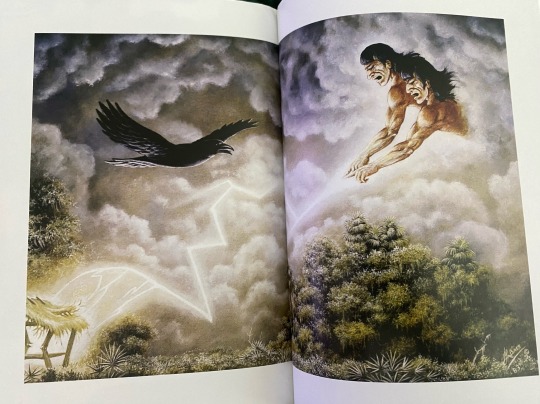
In Seminole belief, Twins are intrinsically tied to the weather. Many elders believed that keeping twins together can be dangerous, and they should be raised separately. To them, one is Thunder and the other is Lightning, even going as far to saying that having two twins in the same chickee can cause it to be struck.
In Taíno myth, we have two sets of twins associated with weather. Boinayel and Marohu are the Cemi related to the Wet and Dry seasons, Boinayel being the Raingiver and Marohu literally meaning “Without Clouds”. Then we have the ones who I would say share similarities to the Seminole Twins, Coatrisque and Gautaubá. These are Twin sons of the violent aspect of Atabey, known as Guabancex, Cacique of winds. Coatrisque is torrential rains, while Guatauba is Thunder and Lightning himself.
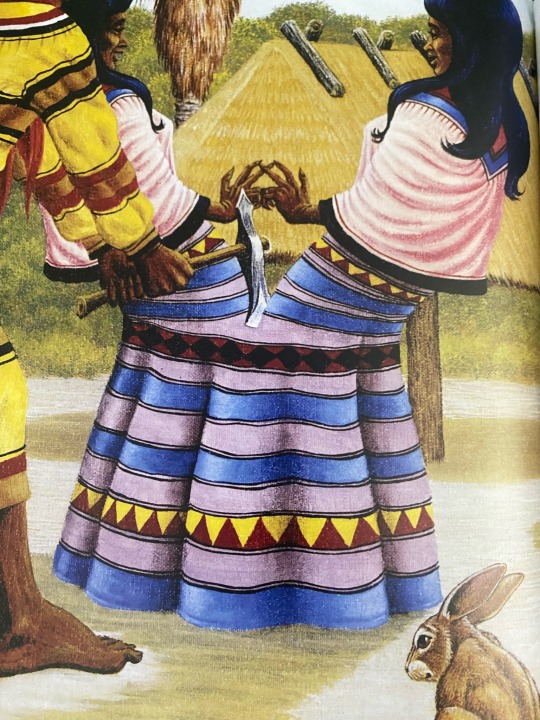
The charm is very well documented in both groups, as well as many others, and very straightforward. It’s the underlying belief that makes these two charms so similar. The linked article from earlier even includes a brief explanation of it.
Basically, when you know a big storm is coming, you want to place an axe in a spot on the front of your house, usually on a piling or piece of the roof that extends below the ground. Tie it down if you wish, for the winds. If you can, do it so the blade looks like it is coming down on the storm. The goal is to split the storm so it goes around the house. If we look at the myths, it’s clear the axe is there to split the Twins from each other, forcing them to go around the house, leaving it protected.
In the Caribbean, in practices like Lúcúmí and Palo Monte, we see the use of Matari, ‘Thunder Stones’. Genuine thunder stones from the Caribbean are actually said to be relics of Taíno axes, shaped like a tear drop almost, either passed down or found and used for various purposes, one being to ward off Lightning and Thunder!
Will Your Kids Know the Glades?
The Everglades are vital to my spiritual practice and lifestyle, as well as that of thousands of other Floridians. Even if you don’t live in the Swamp, its health affects the entire country.
Today, the dangers facing the Everglades are almost as abundant as the dangers inside it. Overdevelopment threatens the entire state. Just like we saw with Split Oak Forest recently. Environmental Protections seem to mean less and less because they don’t have the teeth to defend themselves. Included in these threatened protections is the sovereignty of the Seminole and Miccosukee Tribes, who just had to fight to keep Big Cypress as a preserve so they can continue their traditional use. They are fighting to hold onto their Land to this day.
All while threatening the Traditional Use by Indigenous Peoples, they continue to allow oil drilling even approving new projects within Big Cypress. The Army Corps of Engineers also heavily harms the environment every year through mismanagement of Okechobee and of the water levels within the Glades. It is up to everyday Floridians to fight to protect and better manage this precious natural resource before its gone forever. It is up to Witches all over to be stewards of our Lands, wherever that is. For us Florida Witches, we need to organize, donate and hex our politicians.
Luz 🕯️
#witchcraft#florida#bioregional animism#bruja#brujeria#florida witch#santeria#swamp witch#witch#traditional witchcraft#folk witchcraft#folk magic#folkloric witch#folk witch#espiritismo#santería#caribbean#everglades#animism#taino spirituality#taino#indigenous#cuban#witches#seminole#miccosukee#big cypress
19 notes
·
View notes
Text
Top Attractions to Visit in Fort Myers, FL | Explore Fort Myers
Explore the top attractions in Fort Myers, FL, with Explore Fort Myers. From the vibrant River District to the Edison & Ford Winter Estates, Fort Myers is rich in history, culture, and outdoor adventures. Visit stunning beaches, explore local museums, and enjoy scenic nature parks. Whether you're interested in shopping, dining, or family-friendly activities, Fort Myers offers something for everyone. Discover popular destinations like the Calusa Nature Center, historic downtown, and waterfront parks, making your trip unforgettable. Plan your visit now to experience the best attractions Fort Myers has to offer!
Related Links -
Enjoy Free Events In Fort Myers
Affordable Hotels In Fort Myers
The Best Dining In Fort Myers
Enjoy Live Music In Fort Myers
0 notes
Text

The Caloosahatchee Manuscripts, a work produced by artist Jim Sanborn in 2001, situated along the Caloosahatchee River in Fort Myers, Florida. With these towering, abstract works that spiral around themselves in vertical lines of carved text and icons reminiscent of what the region's native calusa people look like, the artist pays homage to both native american legends, river names and significant historical happenings tied to different aspects the location. Recognized for his work with language, history and cryptography in his pieces, Sanborn uses the sculpture to connect viewers to the cultural and ecological stories of the area.
The sculpture illustrates themes relevant to the historical significance of the Caloosahatchee River, while simultaneously exploring connections between this locale and the indigenous Calusa people; as well as larger human and environmental narratives that course through the region. Cylindrical structures are etched with text in Latin, Spanish and Calusa to emphasise the cultural complexity of the history there. The text is cut into the metal, allowing light to penetrate and create subtle shadows that shift with the time of day.
The sculpture not only signifies that the community honours its cultural heritage but also serves as homage to its history as an economic powerhouse in the Chester region. Grounded firmly in the past, The Caloosahatchee Manuscripts enshrines this through indigenous languages and historical exploration that reveal the community to be a people dedicated to our roots, but accordingly mindful of place and natural history.
The way in which the sculpture interacts with light, water and its setting overall are dynamically engaged also such as to ensure it changes hour by hour. The enormous structure, combined with the ritual of light and shadow during different times of the day, contrasts with viewers' perception of time while leading them to meditate on the layered history and cultural heritage of the river — alongside a community that has endured there for centuries.
0 notes
Text
Peter Wolf Toth is a Hungarian-born American sculptor renowned for his "Trail of the Whispering Giants" series, which includes the "Calostimucu" sculpture in Punta Gorda. Born in 1947 in Hungary, Toth fled with his family to the United States during the Hungarian Revolution of 1956. His experiences as an immigrant influenced his artistic vision, leading him to create sculptures that honor Native American heritage and culture across the United States and Canada.
The Trail of the Whispering Giants project began in 1972, with Toth's goal to create at least one monumental statue in each of the 50 states as a tribute to Native Americans. Each sculpture is unique, often carved from local materials, and reflects the distinct cultural and historical significance of Native American tribes in the area. Toth's dedication to this project shows his commitment to raising awareness about the history and contributions of Native Americans.
The Calostimucu sculpture, specifically, was commissioned in 1974 by Fred Babcock, who was inspired by Toth's work in Georgia. The sculpture's name honors the Calusa and Timucua tribes, symbolizing their struggles and the injustices they faced. Standing 20 feet tall, the sculpture is carved from a tree trunk and is located in front of the Freeman House in Punta Gorda, Florida. The sculpture is surrounded by trees. Its realistic depiction of a Native American face conveys serious and painful emotions, helping viewers understand the historical and cultural significance of the Native American tribes and their experiences.
Toth's work, including Calostimucu, reflects his deep respect for Native American cultures and his desire to preserve their stories through art. His sculptures serve as powerful reminders of the importance of cultural heritage and historical recognition.


0 notes
Text
July 17 - Fulbright center and Shung Ye Museum of Formosan Aborigines




Today started off a bit different than all the other days we’ve had while we were here. Instead of going to a cultural site we visited the Fullbright Center here in Taipei. It was really interesting to hear about all the different opportunities that could be explored. As a rising senior it was especially interesting because I’m right at the time to be considering options like those. Right now my plan is to go to law school in Florida, but who knows if that will still be how I feel by the time I return. Even if I decide against it, I still think I’ll show my friends, since I know some of them could be really interested.
Another cool experience we got to have at the fullbright center was getting to try some local snacks. Of course, I could go to 7-eleven at any time and just grab any random snacks but it was much better for someone to show us their favorites.
After we left we met up with Peter at the station so he could take us to our next location. After a sauna of bus ride and a little bit of walking we were there. The museum itself was very interesting, but I think for many people the most fun part was the dance game they had on the top floor. I also found the section of tattooing really interesting, as it's something I personally love and have two of myself.
In American history classes, not enough time is spent learning about indigenous cultures. This past year, I’m really happy to have taken two classes that spent a significant amount of time talking about these cultures and societies. One class, Florida history until 1845, had a very heavy focus on native Americans, since the time period it covered was almost exclusively them and the Spanish. Learning about the Taiwanese natives was a real pleasure, especially after hearing about how they were displaced yesterday. Something that really surprised me was the similarities between Native Americans and the indigenous people of Taiwan. Tribal tattoos, fabric patterns, and hut styles to name a few similarities I noticed. Something that really caught my attention was how many of their huts were built on still, and therefore off the ground. I spent some time researching the building styles of the Calusa tribe in southwest Florida, and this was common for them too. In their case, they built up so they could avoid the effects of sea level rise. From what I could tell, the indigenous tribes didn't build this way for the same reason, but I still thought it was interesting. It’s very cool to see how despite being a world apart, the conditions these two groups faced led to them developing in similar ways.
1 note
·
View note
Text
Books by Clint Bennett: The Jesuit Warrior and Jason the Slave Warrior
Clint Bennett, Award-winning Author
A fourth-generation Floridian, whose family lived and thrived in the southern part of the Okefenokee swamp near Jasper, Florida, Clint Bennett was born in Dunedin, Florida and moved to Homosassa in 1976.
During four years in the U.S. Navy, he had the opportunity to tour the countries bordering the Mediterranean. Spain was one of his favorite ports of call. Up from the port was a Jesuit monastery, and Clint met and befriended several Spanish Jesuits, learning about their culture and history, especially the horrors of the Spanish Inquisition.
Three topics have always fascinated Clint: the horrendous suffering of the Europeans during the Inquisition, the impact the indigenous tribes of Florida by the arrival of Europeans, and the life and culture of the west Central Florida indigenous populations.
The Jesuit Warrior
After retiring from his professional writing job in 2000, Clint seriously researched and studied the Nature Coast area’s indigenous culture to begin creating his first novel, “The Jesuit Warrior,” a work of historical fiction that tells the story of a disillusioned Jesuit student living in Valencia, Spain during the Spanish Inquisition.
After witnessing a personal horror that causes him to question the teachings and agenda of the Jesuit priests, he boards a ship that will deliver slaves to central Florida. He is captured by the native people in Crystal River. Using his Jesuit medical training as an asset, he becomes a member of the Calusa village, eventually helping them survive attacks by the French and Spanish slavers.
Set in the Nature Coast, from Aripeka to Steinhatchee, including Crystal River and Homosassa, the novel is a wonderful work of historic fiction that grips the reader and teaches about the Calusa, the Timuc and the Appalachia Indian tribes that once thrived on west central Florida’s shores.
There are five-star reviews of his work on Amazon, Barnes and Nobel and other retailers.
Jason, The Slave Warrior
Next, Clint wrote, “Jason the Slave Warrior,” which begins in New Orleans, and is the story of a young slave and his wife who escape their masters during a hurricane. They steal a sailboat, heading for “a place in central Florida where the slavers are afraid to go.” The two make their way to crystal River, where they are welcomed into the Calusa tribe as honored members. Martha is a renown healer, and Jason a welcome translator and who becomes a valued warrior. The geographical setting for the book is primarily Crystal River, the Homosassa River, Steinhatchee north to Deckle – and south to Tampa, Florida. The Calusa, the Timuca, and the Appalachia Indian tribes and their culture are heavily described in this gripping historical fiction novel.
After ordering one, or both, of these novels, email Clint by clicking here to make arrangements for him to autograph your copy.
More About the Author, Clint Bennett
“I was born in Dunedin, Florida in 1945 and have fished and explored the waterways from Dunedin to Steinhatchee since I was old enough and strong enough to hold a paddle, a set of oars, or operate an outboard motor. I have canoed, camped, and explored most of the Suwannee River from the Okefenokee Swamp to Branford, Florida. Today I live in Crystal River, Florida with my wife and we continue to fish and explore the areas described in my books. I will gladly sign and personalize copies of my books,” Clint explains.
"During four years in the U.S. Navy, I had the opportunity of tour the countries bordering the Mediterranean Sea. Spain was one of my favorite ports of call. The squalid conditions in Spain during the early 18th century are accurate as described. My experiences in Europe helped to further my interest and research into the Spanish Inquisition and the numerous diseases and plagues that so devastated Europe for centires. I have also spent time in South Africa where I became interested in the horrors experience by the slaves and the savagery of their captors."
Read the full article
0 notes
Text
Lee county, Florida foundation repair

Lee county Florida
Lee County, Florida is one of the most desirable places to live, work, and visit in the United States.Located on the southwestern coast of the state, Lee County is home to award-winning beaches, a flourishing business climate, and a vibrant culture.Whether you're a first-time visitor or a long-time resident, Lee County has something to offer everyone. From nature and wildlife preserves to historical sites and vibrant downtowns, Lee County is an oasis of activity, culture, and adventure. In addition to its beautiful landscape, Lee County is known for its strong business environment and highly educated workforce.Many businesses have chosen to relocate their headquarters or open new offices in Lee County, making it a top destination for entrepreneurs and business leaders. With its abundant sunshine, warm climate, and low cost of living, Lee County is an attractive destination for retirees and families alike.With its diverse communities, exciting attractions, and rich culture, it's easy to understand why Lee County is a very popular place to call home.
Hurry! Fill this form to talk to a Florida foundation pro!
* indicates required
First Name
Last Name
Email Address *
Phone Number
Describe briefly what the problem seems to be
Marketing Permissions
Please select all the ways you would like to hear from Florida Foundation Pro:
Email phone
You can unsubscribe at any time by clicking the link in the footer of our emails. For information about our privacy practices, please visit our website.
We use Mailchimp as our marketing platform. By clicking below to subscribe, you acknowledge that your information will be transferred to Mailchimp for processing. Learn more about Mailchimp's privacy practices here.
Where is Lee county in Florida and what is there to do? Lee County is located in Southwest Florida on the Gulf Coast. It is a vibrant and diverse community, and the largest county in the state.It's home to a variety of attractions, from the white sand beaches of Sanibel and Captiva Islands, to Caloosahatchee National Wildlife Refuge and the hundreds of species of birds that inhabit it, to South Florida's only drive-in movie theater.The county's downtown area is a cultural hub, with art galleries, restaurants and boutique shops. There are also plenty of outdoor activities to enjoy, such as fishing, kayaking, biking and hiking. Lee County is also home to numerous festivals, such as the Calusa Blueway Paddling Festival and the Shrimp Festival.Whether you're looking for a relaxing beach getaway or an exciting adventure, Lee County is the perfect destination.

Should I buy a house in Lee county, FL?Lee County, FL is an ideal location for potential homebuyers to consider.Situated in Southwest Florida, the county offers a variety of activities and attractions for families and individuals alike. With plenty of outdoor activities such as golf courses, kayaking, fishing, and more, there is something for everyone.Additionally, the cost of living in Lee County is much lower than the national average, making it a budget-friendly option.Home buyers should also consider the area’s strong job market, vibrant cultural scene, and excellent school systems.With all of these factors in mind, Lee County, FL is a great option for potential homebuyers who are looking for an affordable and enjoyable place to call home.What are the house foundation problems in Lee county Florida and how can they be repaired? Lee County, Florida is prone to experiencing foundation problems due to the expansive soil and high water table.Signs of foundation problems can include cracks in the drywall, sticking windows and doors, and uneven or sloping floors. To repair these issues, the homeowner should first inspect the foundation and determine the cause of the issue.This may involve having a professional come to assess the damage and provide options for repair. Solutions may range from simple repairs such as filling gaps or replacing cracked concrete blocks, to more extensive repairs such as underpinning or installing foundation piers. The best option for repairing house foundation problems in Lee County will depend on the severity of the damage and the type of foundation present.Once the cause of the damage is determined, the homeowner will be able to make an informed decision on the best course of action.
Read the full article
0 notes
Note
I have a question? Let’s say if a Cuban spiritualist was from Pinar del Rio and they have indigenous ancestry however sources say the Ciboney Taino inhabited Pinar del Rio and other sources say the Guanahatabey inhabited Pinar del Rio and other sources say both inhabited land, then which source should that person trust? And do we have information on the Guanahatabey spirituality?
Hey! This will be a long answer about Indigenous Caribbean Identity so check below the cut for more!🌺🌴🐠🦜🌀🦩🥭🍋🟩🥥
This is a complex question. I would say the biggest thing to remember is that the term “Taíno” is an umbrella term to reference many different ethnicities of Arawak-Speaking Indigenous Caribbeans. There were many types of Taíno people, including Timucua and Tequesta in Florida, Lucayo in the Bahamas, Ciguayo in Kiskeya and Igneri in Boriken.
As for the term Ciboney, some say it was a separate tribe but the general consensus is that they were a Taíno ethnicity with a separate but mutually intelligible language. They were connected culturally to groups from Jamaica, Florida, Bahamas and modern day Haiti, where as Taínos of the eastern Caribbean were closer in culture. They also had language connections to the Macorix and Guanahatabeys being Waroid languages, aka where we get the term Guajiro. So the Ciboney are a Taino-Arawak group that had ancestrally mixed with the Waroid Guanahatabeys but still maintained moslty Taíno culture.
There were also many other groups who weren’t Taíno. The most well known is the Kalinago, but the Guanahatabey is one from Cuba that is also known to actually have been in Cuba BEFORE the Taínos got there. They had a culture very similar to the Calusa of Southwest Florida. And this is all pre-Colonization, so these groups were already interacting and moving around for thousands of years.
Then with colonization, many Native groups were transported to other places, and in Cuba specifically we have Taíno migrations from the East to the West very early on. We also have Natives from Florida and Mayans from Mexico, and more natives being brought in to cuba and intermarrying with other ethnic groups. These migrations all affected indigenous communities and led to alot of cultural exchange and mixture, as well as loss.
As for Indigenous Cuban Identity, I claim Taíno or Ciboney Taíno because after colonization any remaining Guanahatabeys were assimilated to Taíno Cimarron (maroon/runaway) groups. I consider Guanahatabeys part of my ancestors but I choose to identify as Taíno or simply Indigenous Caribbean. My family all identify as Guajiros, as do I, which is more a lifestyle but definitely has ties to the Classic Taino, Ciboney and Guanahatabey traditions passed down.
As for trusting sources, I would say read EVERYTHING with a grain of salt. Academics often lack cultural nuance and understanding, which can mean alot of their inferences are flat out wrong so try to stick with confirmed info. It is confirmed the Tainos and Guanahatabeys and Ciboneys all moved around and lived in the same parts of the Island at the same time and separately. As for non-academic sources, just be aware that much of what is passed off as Taino or Indigenous Caribbean culture is actually just Pan-Indigenous or straight up a different culture.
Trust yourself, use your intuition and discernment and always be committed to improving and striving for a culturally authentic, fulfilling and respectful practice that is well rounded in both Spirituality and Community! Whether that is with a yukayeke, with the Indigenous tribes you live near locally or with your own indigenous family and friends! So many Yukayekes in the Modern Taíno community try to claim superiority or that they have all the secrets knowledge and the only correct beliefs. You should be weary of anyone trying to restrict you when their own elders often are reconnecting or were just scholars before becoming pop-up Caciques.
If you go to the Cuban version of Wikipedia, when it is active, you can find better information on the Guanahatabey and Ciboney than on American wiki. Try researching the terms ‘Guayabo Blanco’ and ‘Cayo Redondo’ for information on Ciboney culture and beliefs, and how even within this sub-group there were MORE sub-groups. As the Guanahatabeys were not a ceramic culture, we have very little info on them academically. Try researching Calusa beliefs as they had similar environments and were connected through trade routes.
If you have any more questions I would love to answer them but you should ask them on insta or in chat so I can link easier and answer in more depth!!
My asks are always open still tho :)
Luz y progreso
#witchcraft#florida#bioregional animism#bruja#brujeria#florida witch#santeria#swamp witch#witch#traditional witchcraft#taino spirituality#taino#ciboney#indigenous#floridasprings#agua dulce#caribbean#indigenous caribbean#carib#caribe#kalinago#calusa#seminole#native american
4 notes
·
View notes
Text
In Search of the Calusa 2
In Search of the Calusa 2
-Ed, Estero Bay, Lee County, FLIn Search of the Calusa 2-Mound Key to Marco Island, May 8-13, 2022.
In Calusa 1, Ed, Mindi, and I learned about villages of the Calusa that once existed right in downtown, Ft Meyers. Soon after, we visited an even more remarkable remnant, the Mound House seven miles away on Ft Meyers Beach.
Continuing our journey, we headed south along Estero Bay, an aquatic…
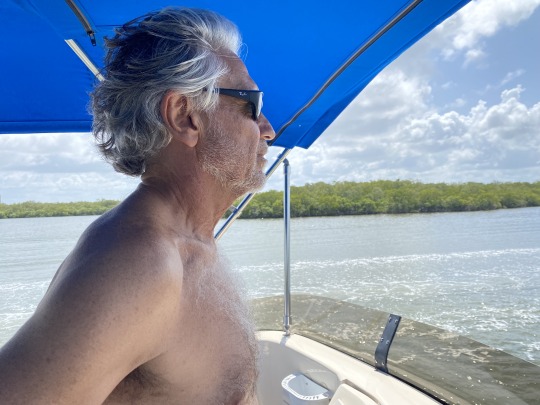
View On WordPress
#Archeological history Key Marco Cat#artifact replicas Calusa#Austin Bell#Calusa artifacts#Calusa culture#Calusa history made easy#Calusa Indians#Cushing#Estero Bay#Frank H. Cushing#In Search of the Calusa 2#Marco Cat#Marco Key#Mound Key#Mound Key Calusa#Mound Key capital#Old Marco Inn#Panther Man God#W.D. Captain Bill Collier#Wells M. Sawyer
0 notes
Text
Pre-contact Native American Cities
There were a number of large population centers in the Americas. I will be focusing on those in what is now the US and Canada, but large cities also existed south of the Rio Grande.
Generally considered the greatest pre-Columbian Native American city, Cahokia once sat directly across the river from what is now St. Louis, Missouri. It was settled around 600 CE and existed from 1050-1350 CE, with its apex around 1100 CE. Cahokia likely had more than 20,000 people living in (thousands more than London, at the time) and was the most influential urban settlement of the Mississippian culture.
Cahokia, on the Mississippi River, was an important center for trade and agriculture. It maintained trade links with communities from the Great Lakes to the Gulf Coast and had people living outside the main urban center. Cahokia, and the Mississippians who built it, were known for their incredible urban planning and the mounds that made up the city center. Today, the Cahokia Mounds are a UNESCO World Heritage site.
Second, the Poverty Point (named after a 19th-century plantation on top of it) culture was centralized in what is now northeastern Louisiana. Like Cahokia, it had a number of important mounds for urban life. It was constructed over multiple generations, and radiocarbon dating suggests that earthwork construction was in progress from 1800-1200 BCE. Poverty Point is one of the most ancient cities in the Americas. Poverty Point had a rich material culture include fired earthware, copperwork, and stone vessels. They had manufacturing and long-distance trade.
Third, the Calusa (Caloosahatchee) people of the southwest coast of Florida, on the coast of the Gulf. They also built mounds and, at the time of European contact in the 16th century, had a population in the 10,000s. They were likely the only indigenous North Americans who established a kingdom without practicing agriculture, using the abundant fishing resources instead. The main mound, Mound Key, was a manmade structure with canals, watercourts, and other features. The Calusa were notable for their carved-wood art and their sophisticated engineering and architecture. A single manor on Mound Key was capable of holding 2,000 people.
Fourth, the Mogollon culture was one of the major cultures of southwest America. It had multiple large and dense settlements, but one that's considered a proper city. Called Paquimé, it was settled from 1130-1450 CE. It had a population in the thousands, who lived in multi-story buildings and an irrigation-based agricultural economy. They had a complex system of water control that included drainage, reservoirs, channels, and sewage. The city had a market, ballcourts, and the production of copper and ceramic objects.
The final city to discuss is Etzanoa. Located in what is now Arkansas City, Kansas on the Arkansas River, it actually flourished after and alongside European contact, mostly with the Spanish. Etzanoa housed approximately 20,000 people. It was a seat of power for the Wichita and a trading hub.

[Image Description: A black and white map of the United States. States are outlined but not labeled. Five stars mark the location of cities. Cahokia is on the border of Arkansas and Illinois. Etzanoa is on the border of Kansas and Oklahoma. Poverty Point is on the border of Louisiana and Mississippi. Mound Key is in southern Florida. Paquimé is slightly below New Mexico.
#history#world history#national native american heritage month#native american history#indigenous history#history they didn't teach you in school#pueblo#cahokia#caddo#calusa#mogollon#etzanoa#wichita#poverty point#map#ancient#antiquity#urban planning#urban design#ancient civilizations
46 notes
·
View notes
Note
About Native American archaeology, I grew up on an island that was part of the calusa tribe territory and there was traces of them everywhere! All you had to do was look!! My favorite was a MASSIVE “trash mound” (idk if that’s correct but that’s what it was called) where you could dig to find stuff like beads or shell hammers! It annoys me so much when ignorant people imply that natives sat around and did nothing the 7000+ years they were here before European colonizers
We would call that a midden!
There's so much stuff that Native people did and made, but sometimes it's hard to find because there's so much space in North America as opposed to the very dense population of Europe.
Also there are still people making amazing crafts that should get equal attention. Incredibly skilled artisans that should be celebrated and supported!!! And languages and cultural traditions!!!
Really, it's that guy's loss for writing off a huge number of amazing cultures.
-Reid
45 notes
·
View notes
Photo

We know very little about the ancient people that once inhabited Big Cypress National Preserve in Florida. Scant evidence reveals a culture known as the Calusa, who first ventured into this vast swamp over 4,500 years ago. In this sea of grass, they found a wetlands cornucopia, feasting on large amounts of fish, deer, shellfish, reptiles, plums, berries and more. First contact with European explorers led to conflict and disease. By the 1800s, the remaining Calusa were absorbed into the Seminole and Miccosukee tribes. Today, archaeologists continue to roam this unique environment, looking for clues of a lost culture. Photo by National Park Service.
#big cypress national preserve#big cypress#national park service#nps#Florida#South Florida#usinterior#findyourpark#find your park#public lands#nature#travel#outdoors#america's great outdoors#wetlands#blue sky#amazing view#awesome experience#gorgeous scenery
304 notes
·
View notes
Text
Fort Myers IMAG History & Science Center
Fort Myers IMAG History & Science Center (Formerly Imaginarium Science Center)
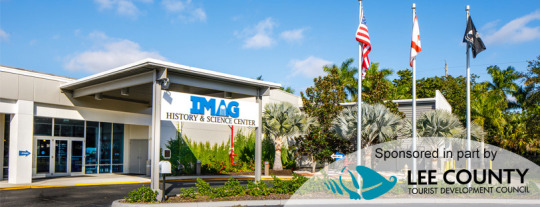
IMAG History & Science Center located at 2000 Cranford Ave., Fort Myers, FL. This is no ordinary museum. Located in Fort Myers, Florida, this science, and aquatic museum is such a unique hands-on experience for young and old alike. Exhibits include the Calusa culture (native tribe), dinosaurs and fossils, aquariums with touch tanks with stingrays, live native small animals, interactive displays including topics about weather and nanotechnology. So much to learn the museum even offers a summer camp! This is such a unique science museum and aquarium that features science exhibits, dinosaurs, 3-D theatre shows as if you were actually there in person. Hours of fun at this unique center. Explore and discover the wonders of science and history with over 60 hands-on exhibits at your fingertips. See the original fort of Fort Myers in the one-of-a-kind 3D Virtual Reality Experience lab. See Florida exotic fish that are native to Florida in their 3200-gallon tank which was built by Animal Planet. Feed the stingrays, touch animals, and visit the living lab and see snakes, frogs, sea turtles and so much more. Truly a one of kind experience that you can revisit again and again and feel as if it was your first visit.
Please visit the business of one of our regular supporters.
Google Map- https://goo.gl/maps/DPkoEzb47bRCy8NB7
Roy's Wildlife and Pest Control, Fort Myers, Florida, United States
Please visit this attraction also.
1 note
·
View note
Text
What Is Sustainability
“The question is not whether we will change, but how, and what form the transition will take.” (Robertson, 2014)
Change is most definitely on the rise and it has been for centuries. Humans generally choose to ignore the fact that change is always happening around and even within us. Unfortunately, where the environment stands, change is not in our favor. Over hundreds of years people have taken from the Earth with only self-satisfaction in mind; disregarding the fact that even though resources were abundant, they were not infinite. As generations go by, we have begun to open our eyes to the world changing around us and have begun our own change of pace in a more positive direction as well. As long as we keep history in mind, we will realize that the Earth goes through cycles of its own and natural disasters are exactly that... “Natural!” However, humans have still sped up this particular cycle with our many forms of pollution, which is probably why some people believe we are nearing the end of this world as we know it. Can we actually reverse these effects or are we on an inevitable path at this point?

Global warming natural cycle on Earth. http://ossfoundation.us/projects/environment/global-warming/natural-cycle
“In the first 20th century, many scientists and policymakers saw nature as a resource to be managed for the benefit of humans.” (Robertson, 2014)
I used to work for an animal sanctuary called Calusa Nature Center as an animal caretaker for multiple different exotic animals. My favorite animal there was a male bobcat who had his claws removed and was owned as a pet. He was eventually given to Wildlife Services as the owner realized that they could not care for an adult bobcat any longer. I have dealt with many animals with similar background stories and the plot is the same in all of them. The animals were put in captivity for human benefit, and then couldn’t be released back into the wild when people grew tired of them. This is one of the sole reasons that sanctuaries exist all over the world. Without them, many animal species would have already gone extinct. Unfortunately, we can’t save every species and many have still gone extinct and endangered over the years due to human activity. Construction also destroys the homes of thousands of animals only to be replaced with a concrete or wooden home of our own, in which most wild animals would be killed if found. I believe that if we found a more efficient way to build our homes and still share the land with nature, not only humans would benefit, but the whole world.

Habitat destruction due to human activity. https://www.nationalgeographic.com.au/nature/humans-are-still-destroying-wildlife-habitats-more-than-protecting-them.aspx
“Complexity and chaos theory meant acknowledging that while nature does have patterns that can be recognized, nature is unpredictable; it is not only more complex than we know, it is more than we can know.” (Robertson, 2014)
The idea of knowledge is a funny thing. A person’s biggest weakness could be the need to know more. This is only because this quote holds true in that we can never truly know everything about nature. Nature is an extremely unpredictable force that reacts on its own accord. Florida is an easy example of that as any local would know. The weather can be bright and sunny in the morning, overcast by midday, and thunderstorm by nightfall. Some cultures see nature as an actual living entity, in which we are only playing a small role. Science can only answer so many questions about this universe and how it works. We have come a long way in understanding the mechanisms of nature but there are still so many areas that have been left in the dark. Some say their greatest fear is of the unknown. What I find funny is that the unknown can be so terrifying, but it can also be humbling at the least. When you accept the unknown for what it is, and the fact that we are nothing but tiny creatures floating on a rock orbiting a ball of fire in a vast, never ending universe, a certain peace of mind comes along. It’s that or insanity. However, I must say, the need to know more is what has driven mankind to where it is now. Some may say that’s a good thing and some may think otherwise. It’s probably safe to say that it is a bit of both. Learning new things is what keeps us going and our minds functioning, but it is also what has caused us to alter nature, leading to unexpected effects.

Unpredictable volcanic eruption in Stromboli. https://www.pinterest.com/pin/241575967496129018/
1 note
·
View note